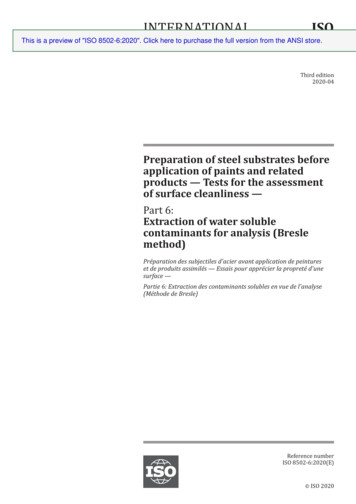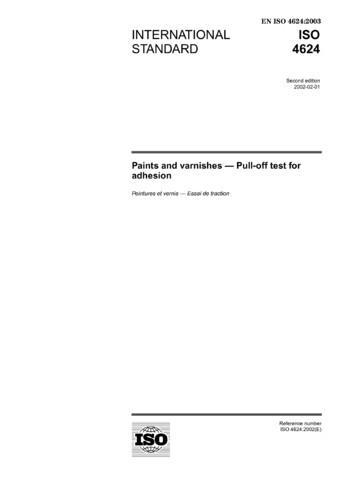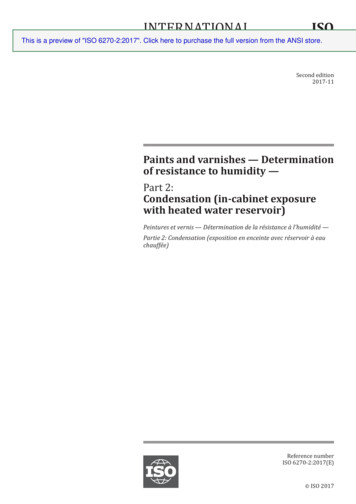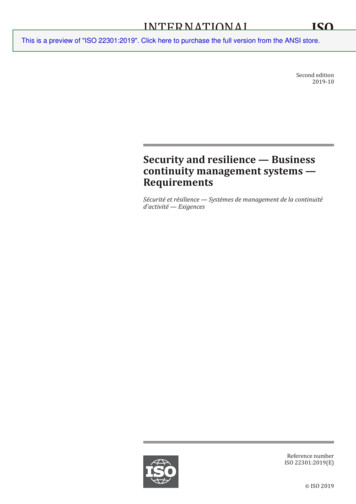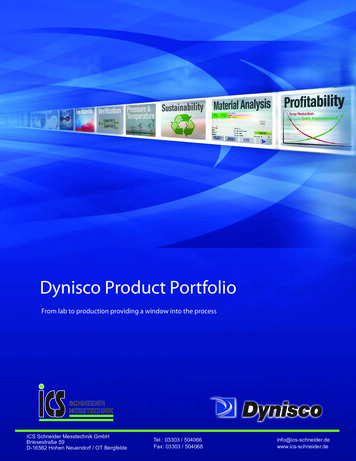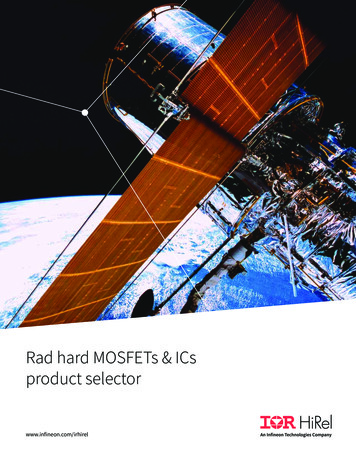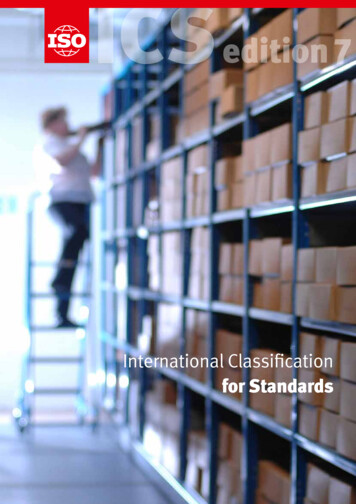
Transcription
ICS edition 7International Classificationfor Standards
International Classificationfor StandardsIntroduction.3Purpose of the ICS. 3Description of the ICS. 3Rules for the use of the ICS. 5Updating of the ICS .11How to use the ICS index. 11List of the ICS fields. 12Systematic table of fields, groups and sub-groups. 15International Classification for Standards 2015 1
International Classification for Standards, 2015Seventh editionISBN 978-92-67-10652-6 International Organization for Standardization
Introduction1 - Purpose of the ICS1.1 The ICS (International Classification for Standards) is intended to serve as a structurefor catalogues of international, regional and national standards and other normative documents, and as a basis for standing-order systems for international, regional and nationalstandards. It may also be used for classifying standards and normative documents in databases, libraries, etc.1.2 The ICS should facilitate the harmonization of information and ordering tools such ascatalogues, selective lists, bibliographies, and databases on magnetic and optical media,thus promoting the world-wide dissemination of international, regional and national standards and other normative documents.2 - Description of the ICS2.1 For the purposes of this document, the general term “ standard ” is applied to all international, regional and national normative documents, such as standards, technical reports,standardized profiles, technical specifications, technical regulations, guides, codes ofpractice, technology trends assessments, etc. and the drafts of such documents.2.2 The ICS is a hierarchical classification which consists of three levels.2.3 Level 1 covers 40 fields of activity in standardization, e.g. road vehicle engineering,agriculture, metallurgy. Each field has a two-digit notation, e.g.43ROAD VEHICLE ENGINEERING2.4 The fields are subdivided into 392 groups (level 2). The notation of a group consists ofthe field notation and a three-digit group number, separated by a point, e.g.43.040 Road vehicle systems2.5 144 of the 392 groups are further divided into 909 sub-groups (level 3). The notation of asub-group consists of the group notation and a two-digit number, separated by a point, e.g.43.040.20 Lighting, signalling and warning devices2.6 A number of group and sub-group titles are followed by scope notes and/or referencenotes, indicated by asterisks and printed in italics in the ICS. A scope note, as a rule, listssubjects covered by a given group/sub-group or defines the subject of a given group/subgroup. A reference note refers to a subject, related to a given group/sub-group, which iscovered by another group/sub-group.International Classification for Standards 2015 3
2.7 All groups divided into sub-groups contain, with a few exceptions, a sub-group whichcovers the complete subject of the respective group. Such general subject sub-groups havenotations terminating with “ .01 ”. For example, the group07.100 Microbiologycontains as a first sub-group07.100.01 Microbiology in generalwhich shall include standards covering the subject of microbiology in general, e.g. thestandardISO 21528-1:2004, Microbiology of food and animal feeding stuffs – Horizontalmethods for the detection and enumeration of Enterobacteriaceae – Part 1 : Detectionand enumeration by MPN technique with pre-enrichmentwhile standards covering medical microbiology, microbiology of water, food microbiology orcosmetics microbiology shall be included respectively in other specific sub-groups : 07.100.10,07.100.20, 07.100.30 or 07.100.40.2.8 Most of the groups divided into sub-groups contain a sub-group having the notationterminating with “ .99 ”. Such sub-groups include standards on subjects which do not correspond either to the subjects of the general sub-groups or to the subjects of the specificsub-groups of the respective groups. For example, the subject of the standardISO 10945:1994, Hydraulic fluid power – Gas-loaded accumulators – Dimensions ofgas portsdoes not correspond either to the subject of the sub-group23.100.01 Fluid power systems in generalor to the specific subjects of the sub-groups23.100.10 Pumps and motors23.100.20 Cylinders23.100.40 Piping and couplings23.100.50 Control components23.100.60 Filters, seals and contamination of fluidsIn this case, it shall be included in the sub-group23.100.99 Other fluid power system componentsThe above rule does not apply in the ICS if all standards related to a group can be includedeither in the general sub-group or in the specific sub-groups.For example, the group21.100 Bearingscontains the general subject sub-group21.100.01 Bearings in generaland specific sub-groups21.100.10 Plain bearings4 International Classification for Standards 2015
21.100.20 Rolling bearingsThe group does not contain a sub-group21.100.99 Other bearingssince all bearings belong only to two types of bearings : plain bearings and rolling bearings.3 - Rules for the use of the ICS3.1 The latest edition of the ICS with the subsequent issues of the ICS Update should be usedfor indexing standards and other normative documents and their drafts. Before indexingstandards for the first time, the indexer should first carefully study the present rules andthe ICS structure.3.2 Standards should be classified according to their subjects. The indexer should firstidentify the appropriate field for a given subject, then allocate the appropriate group notation,and, further, the sub-group’s notation if the group is subdivided. For example, the standardISO 3412:1992, Road vehicles – Screened and waterproof spark-plugs and theirconnections – Types 1A and 1Bbelongs to the field43ROAD VEHICLE ENGINEERINGThe appropriate group within the field is43.060 Internal combustion engines for road vehiclesand the appropriate sub-group within the group is43.060.50 Electrical equipment. Control systemsIf the field of application of a standard is not clear from its content, indexers may take intoaccount the scopes of the relevant technical committee, subcommittee and working groupresponsible for the development of the standard.3.3 The alphabetical index of the ICS may be used as a supplementary tool for identifying theappropriate field, group, sub-group, but the notations found in the index shall be carefullyverified against the systematic table. The reason is that only the systematic table contains thefull information relating to a group notation, such as its title, the field to which it belongs, thesubdivision into sub-groups, sometimes the scope note, and the reference note(s) showingits relationship with other group(s) or sub-group(s). Otherwise errors in indexing may occur.3.4 It is recommended to use all levels available for classifying a given standard. For example, the standardsISO 5358:1992, Anaesthetic machines for use with humansISO 7864:1993, Sterile hypodermic needles for single useISO 7740:1985, Instruments for surgery – Scalpels with detachable blades – Fittingdimensionsshould be classified respectively in sub-groups 11.040.10, 11.040.25 and 11.040.30 (level3) ; it is not recommended to allocate notation 11.040 (level 2) to the above standards sinceit may create difficulties in the exchange of ICS data between databases and will impedeapplication of the ICS in multinational information systems.International Classification for Standards 2015 5
3.5 Standards classified according to this classification may be included in more than onegroup or sub-group ; e.g. the standardISO 7686:2005, Plastics pipes and fittings – Determination of opacityshall be included in the two sub-groups23.040.20 Plastics pipes23.040.45 Plastics fittingswhile the standardISO 8159:1987, Textiles – Morphology of fibres and yarns – Vocabularyshall be included in the three sub-groups01.040.59 Textile and leather technology (Vocabularies)59.060.01 Textile fibres in general59.080.20 YarnsHowever, it is recommended to avoid the allocation of more than four notations to onedocument.3.6 Standards included in the groups01.040 Vocabularies01.060 Quantities and units01.070 Colour coding01.075 Character symbolsand the sub-groups01.080.20 Graphical symbols for use on specific equipment01.080.30 Graphical symbols for use on mechanical engineering and construction drawings, diagrams, plans, maps and in other technicalproduct documentation01.080.40 Graphical symbols for use on electrical and electronics engineering drawings, diagrams, charts and in relevant technical productdocumentation01.080.50 Graphical symbols for use on information technology and telecommunications technical drawings and in relevant technical productdocumentation17.140.20 Noise emitted by machines and equipment17.140.30 Noise emitted by means of transportshall also be included in other groups and/or sub-groups according to their subjects ; e.g.the standard6 International Classification for Standards 2015
ISO 1942:2009, Dentistry – Vocabularyshall be included in the two sub-groups01.040.11 Health care technology (Vocabularies)11.060.01 Dentistry in generalwhile the standardISO 6405-1:2004, Earth-moving machinery – Symbols for operator controls and otherdisplays – Part 1 : Common symbolsshall be included both in the sub-group01.080.20 Graphical symbols for use on specific equipmentand in the group53.100 Earth-moving machinery3.7 A standard containing definitions which apply only for the purpose of that standardshall not be classified into the group01.040 Vocabularies3.8 Amendments, addenda and technical corrigenda to a standard shall have the samenotations as the standard itself.3.9 Standards for systems, components, spare parts and materials used for specific equipment, machines and installations should be classified in the respective groups and subgroups containing standards for the equipment, machines and installations if the ICS doesnot contain groups or sub-groups specially designated for classifying the relevant systems,components, spare parts and materials. For example, standardISO 5696:1984, Trailed agricultural vehicles – Brakes and braking devices – Laboratorytest methodshould be included in the sub-group65.060.10 Agricultural tractors and trailed vehiclessince the ICS does not contain a group/sub-group for braking systems of agricultural machinery, while the standardISO 4251-1:2005, Tyres (ply rating marked series) and rims for agricultural tractors andmachines – Part 1 : Tyre designation and dimensions, and approved rim contoursshould be included in the sub-group83.160.30 Tyres for agricultural machinery3.10 Where a group is further subdivided into sub-groups, only the notations of the subgroups shall be allocated to standards, e.g. the standardISO 4254-1:2013, Agricultural machinery – Safety – Part 1 : General requirementsshall be classified under the title of the sub-group65.060.01 Agricultural machines and equipment in generaland not under the title of the groupInternational Classification for Standards 2015 7
65.060 Agricultural machines, implements and equipment3.11 If the subject of a standard covers two or more sub-groups within a group which containsonly these sub-groups plus sub-groups with notations terminating with “ .01 ” and/or “ .99 ”,i.e. the subject covers all of the specific sub-groups, that standard shall be classified underthe sub-group which has the notation terminating with “ .01 ”, e.g. the standardISO 4829-1:1986, Steel and cast iron – Determination of total silicon content – Reducedmolybdosilicate spectrophotometric method – Part 1 : Silicon contents between 0.05and 1.0 %shall be classified under the title of the sub-group77.080.01 Ferrous metals in generaland not under the titles of the sub-groups77.080.10 Irons77.080.20 Steelssince irons and steels completely cover the ferrous metals subject.Similarly, the standardISO 6632:1981, Fruits, vegetables and derived products – Determination of volatileacidityshall be classified under the title of the sub-group67.080.01 Fruits, vegetables and derived products in generaland not under the title of the sub-groups67.080.10 Fruits and derived productssince67.080.20 Vegetables and derived products67.080 Fruits. Vegetablescontains only67.080.01 Fruits, vegetables and derived products in general67.080.10 Fruits and derived products67.080.20 Vegetables and derived products3.12 A sub-group, or a group which does not have sub-groups, may be further subdividedby the user into respectively either several units (level 4) or new sub-groups (level 3). For thepurpose of distinguishing subdivisions (units or new sub-groups) from those given in theclassification, new notations shall be created using a hyphen as a separator, followed by atwo-digit number ; e.g. the group53.100 Earth-moving machinerymay be subdivided into the following new sub-groups53.100-01 Earth-moving machinery in general8 International Classification for Standards 2015
53.100-10 Tractors53.100-20 Excavators53.100-30 Loaders53.100-40 Graders53.100-99 Other earth-moving machineryHowever, such subdivisions should be used very restrictively and avoided wherever possible.The preferred solution should be to address the question to the ISO Central Secretariat whichis responsible for the maintenance and development of the ICS.3.13 A semicolon should be used for separating notations in printed documents. To provideconsistency in the presentation of notations, they should be sorted in ascending numericalorder, e.g. ICS notations for ISO 8159:1987 should be indicated as follows : ICS 01.040.59 ;59.060.01 ; 59.080.20.For data exchange, the rules set up in the second edition (1998) of the ISONET Manualshould be used.3.14 Fields21MECHANICAL SYSTEMS AND COMPONENTS FOR GENERAL USE23FLUID SYSTEMS AND COMPONENTS FOR GENERAL USEand also the fields and the groups for which the scopes contain an indication that this fieldor group includes standards for general use, e.g.13.110 Safety of machinery*This group includes standards only for general useshall contain only standards for general use which may be applied by different industries.For example, the standardISO 10317:2008, Rolling bearings – Tapered roller bearings – Designation systemwhich may be applied by different industries, shall be included in the sub-group21.100.20 Rolling bearingswhile standardsISO 6045:1987, Shipbuilding and marine structures – Bearings for derrick goosenecks– Assemblies and componentsandISO 14204:1998, Aerospace – Airframe ball bearings, double-row, rigid, diameterseries 0 – Metric serieswhich are designated for application by specific industries, shall be included respectivelyin the sub-groups related to those industries, namelyand47.020.40 Lifting and cargo handling equipment49.035 Components for aerospace constructionInternational Classification for Standards 2015 9
The standardISO 6259-1:1997, Thermoplastics pipes – Determination of tensile properties – Part 1 :General test methodwhich is applied for general purposes and may be used by different industries, shall beincluded in the sub-group23.040.20 Plastic pipeswhile the standardISO 6993-1:2006, Buried, high-impact poly(vinyl chloride) (PVC-HI) piping systems forthe supply of gaseous fuels – Part 1 : Pipes for a maximum operating pressure of 1 bar(100 kPa)which is designated for specific purposes of natural gas handling, shall be included respectively in the group related to those specific purposes (from the point of view of using theproduct) and in the sub-group related to the relevant type of product (from the point of viewof manufacturing the product), namelyand75.200 Petroleum products and natural gas handling equipment83.140.30 Plastic pipes and fittings for non fluid useThe standardISO 12100:2010, Safety of machinery – General principles for design – Risk assessmentand risk reductionshall be included in the group13.110 Safety of machinerywhile the standardISO 4254-1:2013, Agricultural machinery– Safety – Part 1 : General requirementsshall not be included in the above group since it is designated for use by only one industry, theagricultural machinery engineering sector ; the standard shall be included in the sub-group65.060.01 Agricultural machines and equipment in general3.15 If a group/sub-group has a reference note to another group/sub-group, the standardsrelated to the subject indicated in the relevant reference note shall be classified in thereferenced group/sub-group. For example, the sub-group81.060.20 Ceramic productscontains the reference note*Sanitary ceramic products, see 91.140.70therefore, standards for sanitary ceramic products shall be classified into the sub-group91.140.70 Sanitary installationsand not into the sub-group81.060.20 Ceramic products10 International Classification for Standards 2015
3.16 If an international standard is adopted as a regional and/or national standard, theregional and/or national standard shall have the notation(s) allocated to the internationalstandard. Similarly, if a regional standard is adopted as a national standard, the latter shallhave the notation(s) allocated to the regional standard.3.17 In general, to provide worldwide consistency in indexing, indexers should be guidedby the practices of allocation of ICS notations applied for international standards (in the firstplace) and regional standards.3.18 Identified errors in indexing due to misallocation of ICS notations, transposing of figuresin ICS notations, typographical errors, etc. should be notified to the organization concerned.4 - Updating of the ICS4.1 The classification is updated according to needs. Any user may submit proposals formodifications and/or additions to the ICS. Such proposals should be sent to the ISO CentralSecretariat at the following address :International Organization for StandardizationISO Central SecretariatBIBC IIChemin de Blandonnet 8CP 4011214 Vernier, GenevaSwitzerlandE-mail : central@iso.orgTel. : 41 22 749 01 114.2 All proposals received will be considered and their authors will be informed on anyfollow-up action.5 - How to use the ICS index5.1 The ICS index is presented in a KWIC (key-word-in-context) form. The titles of allfields/groups/sub-groups, scope notes and reference notes (when they do not repeatthe titles of corresponding fields/groups/sub-groups) appear under all words (keywords) which they contain with the exception of stop-words. These are words which arenot significant for search purposes. They include prepositions and such words as “ and ”,“ some ”, “ other ”, “ any ”, “ device ”, “ standard ”, “ designation ”, “ sampling ” andso on.5.2 The keywords (printed in bold characters) are arranged in alphabetical order in a singlecolumn down the page.5.3 Keywords are separated from their titles by a bullet symbol ( )5.4 Notations of fields/groups/sub-groups are given at the left hand column. According totheir numbers, corresponding fields/groups/sub-groups are easily identified in the systematic table of fields, groups and sub-groups.International Classification for Standards 2015 11
6 - List of the ICS fields01 - Generalities. Terminology. Standardization. Documentation.1703 - Services. Company organization. Management and quality. Administration.Transport. Sociology.
ISO 7686:2005 , Plastics pipes and fittings – Determination of opacity shall be included in the two sub-groups 23.040.20 Plastics pipes 23.040.45 Plastics fittings while the standard ISO 8159:1987 , Textiles – Morphology of fibres and yarns – Vocabulary shall be included in the thre




